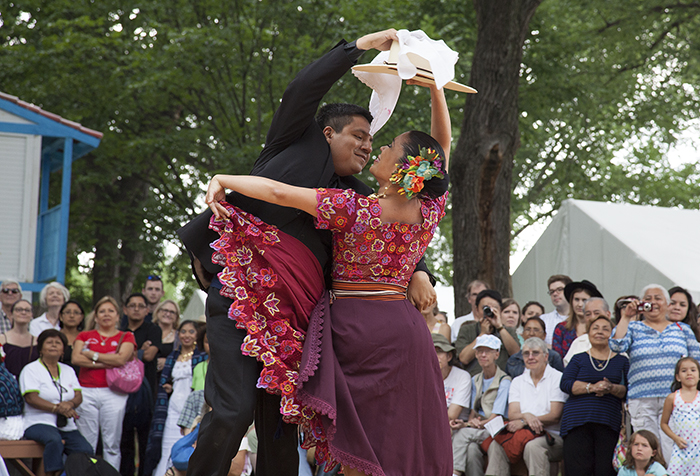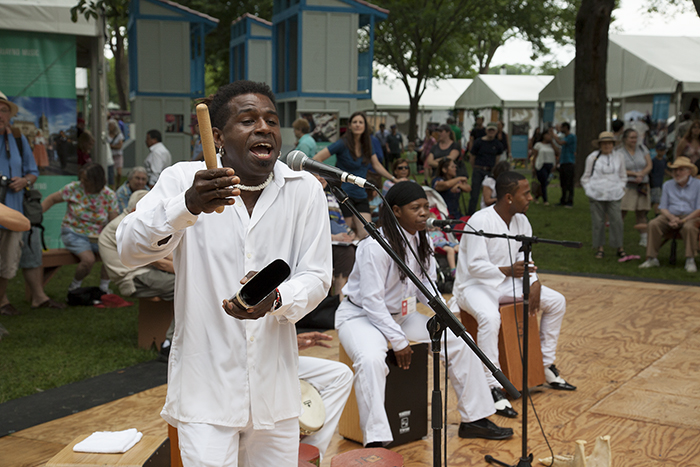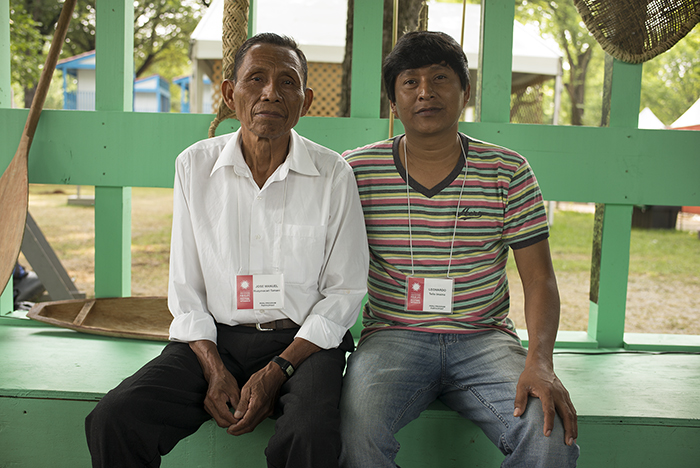Peru and Puerto Rico: Two Rhythms, One Voice

There I was, standing in front of the Smithsonian Folklife Festival main stage, with a circling sway of skirts and handkerchiefs. I was speechless. It was my second day in Washington, D.C., but for a fleeting instant I felt at home. Percussion, guitars, and the sensuality of the Peruvian festejo transported me to Puerto Rico, conjuring the sounds of bomba y plena. Both genres were born from the integration of music and stories reflecting the daily realities of the Afro and criollo (creole) communities. For a moment, the Afro-Caribbean traditions were reflected in this Peruvian reality. It was as if Afro-Latino voices from both sides of the continent talked to me at the same time, with a shared history but a different voice and rhythm. Their message: to be heard, respected, and defended.
From the album Puerto Rico in Washington (Folkways Records, 1971)
Voices like those of Afro-Latinos—strong but in danger of being rendered invisible—need public spaces, not only to be represented but to flourish and be passed onto new generations. It’s precisely in these spaces where they redefine themselves, where they resume the community consciousness in a process of reaffirming who they are and forging their identity. These voices have been and will continue telling their stories, but how they are translated to reality is a multi-layered, ever-changing experience.
Part of this experience came into dialogue at the Perú: Pachamama program. The African, Spanish, and Indigenous joys, sufferings, flavors, and cadences shaped the identities portrayed during the Festival. Artists as varied as Susana Baca and the Afro-Peruvian band Tutuma passed through the same stage. While Susana has become the strongest voice of Afro-descendants from Peru internationally, Tutuma represents Afro-Peruvian traditions on a local level, especially from El Carmen District, Chincha. One is closer to jazz and the other to traditional Afro-Peruvian styles. The Festival served as a facilitator for the international and local spectrum of Peru’s national identity to be in direct dialogue, starting from the joint effort of increasing the representation of Afro-descendant minorities.

In this representation of minorities, I establish bridges of comparison between my country and Peru, both with a history of invisibility of Afro-descendant minorities that dates back to colonial times. In Puerto Rico’s case, invisibility comes in the form of commercialization and trivialization of the Afro heritage. Aspects like language, dance, art, and gastronomy are used more as a tourist attraction than as a cultural affirmation. As a response, strong movements have formed dedicated to the rescue and acknowledgement of African roots and traditions. They are starting to occupy and take back non-conventional public spaces, filling them with Afro-Puerto Rican traditions and art, educating about their heritage, and involving other communities in the performances and pedagogic process.
Minority groups in Peru are making the same kinds of efforts, through arts initiatives and other projects. Miguel Ballumbrosio, member of Tutuma, is creating a community center to gather and celebrate Afro-Peruvian traditions, providing a space of expression for the rich Afro culture his father and siblings helped establish as a significant part of the Peruvian national culture. This is just one of the many strategies to fight against marginalization of minorities and advocate for adequate representation in public spaces and the national narrative.
The struggle to bring minority voices to the national level becomes more difficult and urgent when you add the issues of race and national identity. What does it mean to be Peruvian? Who is Peruvian?

At the Festival, Leonardo Tello from Radio Ucamara said that being from the Peruvian Amazon means “to be the river, the jungle, the people, the spirits.” Then he asked composer and writer Roberto Arguedas what it means to be black.
“Instead of speaking of race, I’ll respond as a human being. I am free, and I don’t like races or differences or nothing like that. I fight for freedom, for freedom of thought, to have the freedom to be able to talk to others with respect. I live to be happy and give happiness to others. I don’t want to use cliché stereotypes about me because that has been done before and I don’t like it. Peru is one nation. We are Peruvians—you and me are Peruvians. We are not races or forms. I love the place I live in and the place you live in. We are a cultural diversity where we are all the same. I’m not original from Peru. I was born in Peru, but we arrived later. You were here before, you welcomed us, and I love my country for that. That’s why I don’t want any color or racial division in my country.”
These “cliché stereotypes” Roberto mentions could and should be fought through the use of public spaces for the education on the invisibility threats that minorities face. In this sense, space becomes crucial in the defense of identity, be it through art, performance, education, community gatherings, or expressing one’s understanding of race. Invisibility is a constant force that should be a call to action, to stand up, embrace, affirm, and defend our diverse heritage.
As Miguel Ballumbrosio says, “We can’t just sit around with our arms crossed waiting for something to happen, because our crossed arms will become rotten.”
José Ralat-Reyes is a Smithsonian Latino Center Fellow at the Center for Folklife and Cultural Heritage. He’s an archaeologist and heritage manager graduate from Autonomous University of Madrid, where he focused his research into the representation of the Afro-Puerto Rican heritage in museum spaces.

